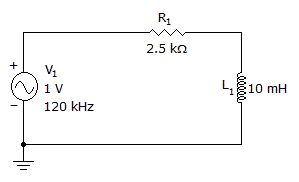Inductors problems
- 1. What will happen when an inductor's magnetic field collapses?
Options- A. Current will double.
- B. Voltage will be induced.
- C. A new field will expand.
- D. Counter emf will be high. Discuss
Correct Answer: Voltage will be induced.
- 2. A voltage is induced in a transformer secondary winding by the action of the:
Options- A. secondary magnetic field
- B. primary turns ratio
- C. primary magnetic field
- D. secondary counter emf Discuss
Correct Answer: primary magnetic field
- 3. Reactance in an inductive circuit will:
Options- A. increase with frequency
- B. decrease with frequency
- C. be independent from frequency
- D. depend on the value of XC Discuss
Correct Answer: increase with frequency
- 4. What is the inductive reactance if the Q of a coil is 60, and the winding resistance is 5 Ω?
Options- A. 0.083 Ω
- B. 12 Ω
- C. 30 Ω
- D. 300 Ω Discuss
Correct Answer: 300 Ω
- 5. You could decrease the time constant of an RL circuit by
Options- A. adding a resistor in parallel with the circuit resistance
- B. adding an inductor in series with the circuit inductance
- C. decreasing the amplitude of the input voltage
- D. exchanging the position of the resistor and inductor in the circuit Discuss
Correct Answer: adding an inductor in series with the circuit inductance
- 6. A magnetic circuit breaker will open to protect equipment only when:
Options- A. voltage is exceeded
- B. an open is in the equipment
- C. the equipment is operating properly
- D. current is exceeded Discuss
Correct Answer: current is exceeded
- 7. When a magnet enters a coil and a voltage is induced, the process is known as:
Options- A. an alternation
- B. self-inductance
- C. counter emf
- D. flux linkage Discuss
Correct Answer: flux linkage
- 8. Electromagnetism is the:
Options- A. magnetic field caused by a permanent magnet
- B. action between a permanent and an artificial magnet
- C. magnetic field action with a current-carrying wire
- D. current in the coil Discuss
Correct Answer: magnetic field action with a current-carrying wire
- 9. What is remanence?
Options- A. reactance
- B. reluctance
- C. retentitivity
- D. resistance Discuss
Correct Answer: retentitivity
- 10. What is the inductive reactance?

Options- A. 5.2 Ω
- B. 7.5 Ω
- C. 1.3 kΩ
- D. 7.5 kΩ Discuss
Correct Answer: 7.5 kΩ
More in Electronics:
Programming
Copyright ©CuriousTab. All rights reserved.
